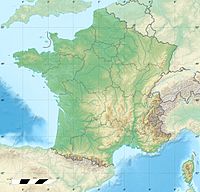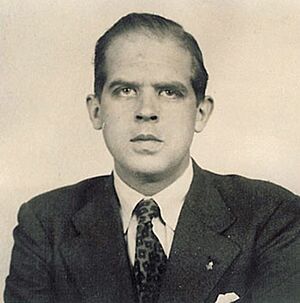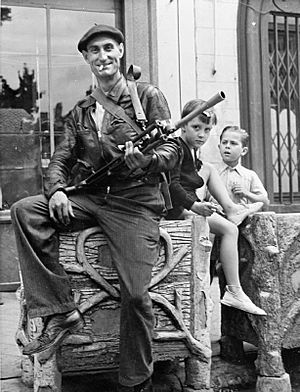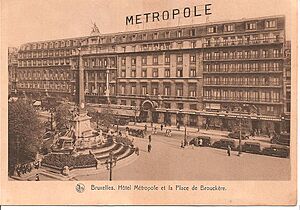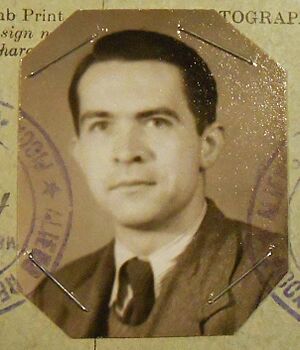Operation Marathon (World War II) facts for kids
Operation Marathon was a secret plan during World War II. It helped Allied airmen who were shot down or crash-landed in areas controlled by Nazi Germany. The goal was to help them avoid being captured by the Germans.
The British intelligence group, MI9, created this operation. They gathered downed airmen into hidden camps in forests. There, the airmen waited to be rescued by Allied soldiers. These soldiers were advancing after the Normandy Invasion on June 6, 1944.
A brave Belgian and French escape network called the Comet Line ran these forest camps. MI9 provided money and supplies to help them.
The most important camp was called Sherwood. It was in the Fréteval forest in France. This camp hid 152 British and American airmen. They stayed there between May and August 1944. MI9 officer Airey Neave and a small Allied team rescued these airmen on August 14, 1944. Other forest camps in France and the Ardennes forest in Belgium helped over 150 more airmen. They were also rescued as the Allied armies moved forward.
Contents
Why Operation Marathon Was Needed
During World War II, many thousands of Allied planes were shot down. They also crash-landed in areas controlled by Nazi Germany. Before Operation Marathon, secret escape networks helped about 5,000 downed Allied airmen. These networks were run by everyday people in France, Belgium, the Netherlands, and Denmark. They helped airmen escape to neutral countries like Spain.
However, in 1944, Allied planes heavily bombed railroads and other transport routes. This made it very hard for airmen to escape to neutral countries. This was especially true as the Normandy Invasion in France was getting closer.
The United Kingdom's military intelligence group, MI9, came up with a new idea. Instead of helping airmen escape far away, they would gather them in hidden forest camps. There, the airmen could wait for the Allied armies to arrive.
Planning the Secret Camps
MI9 officer Airey Neave thought of Operation Marathon in late 1943. He started planning it with three Belgians: Jean de Blommaert, Georges d'Oultremont, and Albert Ancia. All of them had worked with the Comet Line.
They chose three places for forest camps:
- The Freteval forest, about 150 kilometres (93 miles) southwest of Paris. This camp was called Sherwood.
- A forest near Rennes in Brittany.
- The Ardennes forest in Belgium.
Neave began training people for the operation. He secretly parachuted them into France. The three Belgians found open fields for planes to land or for supplies to be dropped by parachute. They also found people living near the proposed camps who were willing to help the airmen.
Working with the Comet Line
In early 1944, the Comet Line had suffered many arrests by German police. But Neave still wanted them to help with Operation Marathon. To work together, British officials met in Madrid, Spain, in February 1944. They met with three surviving Comet Line leaders: Elvire de Greef (known as Auntie Go), Marcel Roger (Max), and Michelle Dumon (Michou or Lily). Michelle was only 22, but she had a fake ID that said she was 16.
The Comet Line liked to work independently from MI9. So, MI9 had to convince them and offer money for their expenses to get them to join the operation.
A Close Call
Operation Marathon almost had a terrible start. A man named Pierre Boulain had been helping de Blommaert and Ancia. They planned to meet him on May 7 in Paris. They were going to give him 500,000 francs (about 2,500 British pounds in 1944) to help with the operation.
However, Michelle Dumon found out that "Boulain" was actually a German agent named Jacques Desoubrie. She quickly warned de Blommaert and Ancia. They avoided capture by the Germans, but Michelle Dumon had to escape to England.
Sherwood Camp: A Safe Haven
In April and May 1944, Jean de Blommaert and another Belgian, RAF officer Lucien Boussa, set up their main office. It was in the town of Cloyes-sur-le-Loir, close to the Freteval Forest. De Blommaert convinced the local French Resistance group to stay quiet. He knew that any fighting would attract German attention and put the airmen in danger.
He also arranged for farmers, bakers, and shopkeepers to deliver food to Sherwood Camp. He worked with Philippe d'Albert-Lake, the head of the Comet Line in Paris, and his American wife, Virginia d'Albert-Lake. They set up a system of guides to bring airmen from safe houses in Paris to the forest camp. Supplies like tents were dropped by parachute into fields near the forest.
Life in Sherwood Camp
The first airmen heading to Sherwood camp took a train from Paris to Chateaudun on May 20. This was a risky trip because Allied planes often bombed the railroads. From Chateaudun, guides led the airmen another 15 kilometres (9.3 miles) to Cloyes. They stayed in safe houses until the camp was ready.
On D-Day, June 6, 1944, when the Normandy Invasion began, thirty airmen were in the camp. This number steadily grew to 152 American and British airmen by early August.
Sadly, Virginia D'Albert-Lake was captured by the Germans on June 12. She was guiding eleven airmen to the camp at the time. She survived the war in a German concentration camp. The Germans also arrested ten local people during the operation in the Freteval Forest. Six of them never returned from prison camps.
The Rescue of Sherwood Airmen
In August, Airey Neave traveled from England to France to pick up the airmen from the forest camps. Neave went to Le Mans, which was controlled by the American army. This was about 75 kilometres (47 miles) from Sherwood Camp.
It was thought that the Germans had left the forest area, but it wasn't certain. The American army was suspicious of Neave and the "armed patriots" he had gathered. So, they refused to give him transportation. With difficulty, Neave finally gathered 16 buses and trucks. They were decorated with flowers and French flags and guarded by civilians with rifles. A few British SAS soldiers also joined them.
They left Le Mans on August 14 for Freteval Forest. They returned the same day with 132 airmen. Another 20 were found the next day. Neave said that most of the 152 airmen rescued from Freteval forest returned to duty. By the end of the war, 38 of them had been killed in action.
Other Camps and Rescues
From Le Mans, Neave, de Blommaert, and their group of armed men traveled toward Paris. The Comet Line had hidden airmen in several towns. Neave collected them as they traveled, even meeting author Ernest Hemingway along the way. Neave and his "army" entered Paris and set up a base to connect with the French Resistance.
As soon as the Allied armies made it safe, Neave left Paris for Belgium. He hoped to find Allied airmen hidden there in the Ardenne forest. He arrived in Brussels in early September, just as the Germans were leaving and the Allied armies were entering the city.
Neave found about 100 airmen and 100 Comet Line helpers at the Hotel Metropole. He thought that the Comet Line had not created camps in Belgium. He believed they had acted on their own, showing a strong "spirit of Belgian independence." A big party followed, and a large bill for the party was sent to General Dwight Eisenhower, the commander of the Allied armies. The bill was eventually paid after much discussion.
In total, Operation Marathon helped shelter and rescue more than 300 downed airmen. From Belgium, Neave continued to the Netherlands for Operation Pegasus. This mission rescued more MI9 agents, airmen, and soldiers who were stuck behind German lines after the failed Operation Market Garden by the Allied armies.
Marathon in Belgium
Neave was mistaken when he thought there were no camps in Belgium. In fact, six camps were created in the Belgian Ardennes. They were still active on Liberation Day.
The Belgian part of Mission Marathon began on April 15. Jean de Blommaert de Soye and Albert Ancia, who had parachuted into France a few days earlier, met Yvon Michiels. Michiels was in charge of the Comet Line in Belgium. Michiels agreed to set up camps in Belgium and offered his escape line members to Marathon.
Back in Belgium, Michiels sent agents to explore possible locations in the Ardennes. His successors, José Grimar and Gaston Matthys, continued this work. When Albert Ancia arrived in Belgium, he worked closely with Gaston Matthys. They worked with Belgian Comet Line members and other agents specially recruited for Mission Marathon.
Airmen were temporarily hidden in places like Brussels and Liège. From there, Marathon members guided them to the Ardennes. They traveled by train, car, and often by bicycle. There was even a "cyclists road" from Brussels to Namur and then to the camps.
The camps were set up in Beffe, Porcheresse (Daverdisse), Villance, Acremont, La Cornette and Bohan. At least 109 Allied airmen stayed in these camps from June to September. This was possible thanks to the Marathon agents and help from local people.
The agents in charge of the camps were:
- Beffe: Vincent Wuyts and his wife Marie Ghislaine Denis
- Porcheresse: Emile Roiseux
- Villance: Walter Haesebrouck
- Acremont: Georges Arnould
- La Cornette: Germain Servais and Gaston Matthys
- Bohan: Hubert Renault
Remembering the Heroes
On June 11, 1967, Jean de Blommaert and Airey Neave returned to the Freteval Forest. They dedicated a stone monument to remember the rescue of the Allied airmen. Lucien Boussa had passed away three months earlier in Cloyes. This was the same town where he and Blommaert had set up their headquarters in 1944.
|


